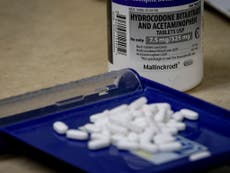After a recent operation, I started taking opioid painkillers – and realised a horrible truth
Constipation is just one of the side effects of these drugs, as well as insomnia, and doctors prescribe extra medication for both. It’s not long before you’ve got so many prescriptions you’re in a spiral

Since my knee replacement operation 17 days ago, I’ve worked diligently at my mobility, icing the new joint four times a day and attempting to work through a chart of exercises in spite of the (receding, but still present) pain.
I’ve made a good recovery and went back on television after two weeks. I managed not to rely on a stick, or a walking support, just grim determination not to be immobile and vulnerable. So far, so good – but now another problem has surfaced, or rather, has not surfaced: my guts have gone into lockdown.
I have become one of the millions suffering from chronic constipation caused by opioid-based painkillers. The minute I woke up in hospital after the operation I was offered dihydrocodeine tablets, and when I was discharged after three days I left with 56 of these pills and I can take up to eight a day. Other pain relief included the morphine I received during the operation, which made my skin itch for days afterwards.
Sleeping was difficult, and so I was offered an antidepressant (amytriptalline) which gave me dreadful anxiety dreams. All this medication was meant to make me feel better, but actually I felt tearful and stoned. It has taken weeks to scale it down, but the effect on my (normally healthy) gut has been dramatic.
All over the UK, people are taking too many painkillers (prescriptions have gone up by 27 per cent of late), and the side effect is that we are seriously constipated. When I tweeted that my guts were locked, I received hundreds and hundreds of suggestions, from natural remedies like pineapple, prunes and figs to more serious “colon-cleansing” pills.
For cancer sufferers and the elderly who are being given Tramadol routinely for pain relief, constipation is a fact of life: the opioids directly affect your bowels. In the end, I took far too many laxatives (four in one day), and although they produced the desired effect, now my stomach is dreadfully sore.
I have weaned myself off the codeine with a glass of wine in the evening, and more ice packs. Sleeping is still intermittent, but I am more concerned about what I have done to my guts.
Earlier this year, I wrote about the over-use of painkillers in the UK – and I worry that sooner or later our doctors will follow their counterparts in the US and start prescribing strong laxatives to opioid addicts, ie anyone who is on Tramadol or a very high dose of codeine for more than three months.
Something appalling is happening in the US as a result of the opioid addiction crisis. The pharmaceutical industry has worked out that every drug produces side effects (in the case of painkillers, that’s constipation) and has created a new condition called OIC (Opioid Induced Constipation).
That means they can design new drugs which claim to deal with it, available only on prescription and targeted specifically towards people on strong painkillers. In marketing terms, these addicts are known as “the opioid use disorder population”.
Take a look at the advertising video for one constipation drug (Movantik) on YouTube, entitled “Erica’s Movantik Moment” – which could be a comedy sketch were it not for real. Smiley, wholesome Erica admits she regularly takes opioids for pain relief (no mention of it being a temporary situation) but after plucking up the courage to call her doctor, she has found relief with Movantik.
This pill (made by AstraZeneca) costs about $10 a day, and the side effects are listed as “opioid withdrawal”, sweating, stomach cramps, diarrhoea… and so on. The pill itself might not be addictive, but its very existence will create a strong need in addicts.
One has to question why doctors are writing out more prescriptions for medication when they are not dealing with the cause: addictive opioids. In 2015 alone, 250 million prescriptions for opioids were written in the US, and the market is worth $10bn dollars a year to the drug companies.
The Washington Post estimates that the potential market for drugs which deal with the side effects is worth between $1.9bn and $4.8bn dollars per year. The number of prescriptions has risen to a point where 57 per cent of American women of working age take more than four prescriptions a day, so that’s a lot of drugs which have side effects as they interact with each other. Movantik’s Erica is aimed directly at these women.
In this country, constipation is a big industry. At one level, the “clean eating” movement with its ludicrous assumption that there’s such a thing as “dirty” food is all about a healthy gut, and it’s extremely seductive to young women.
As it is, young girls with eating disorders often binge on laxatives in order to slim. Ageing brings cancer and arthritis, both conditions requiring pain relief. Routine operations, like my knee replacement, result in temporary extreme pain at the start of the recovery process.
I’ve said it before, but painkillers are responsible for dreadful side effects and it’s time we started to wean ourselves off them. Strong laxatives should not be part of our daily routine.



Join our commenting forum
Join thought-provoking conversations, follow other Independent readers and see their replies